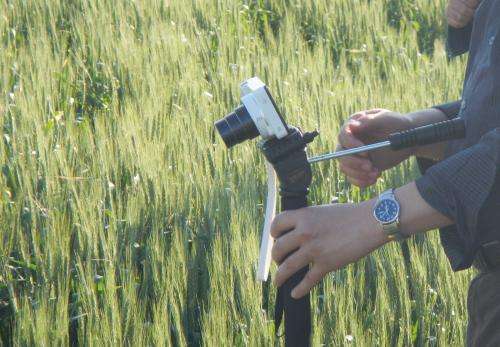Study helps threatened wheat crops in Asia, Africa

Researchers at Oregon State University have helped develop new environmental monitoring technology that will allow farmers thousands of miles away, in west and central Asia, to save millions of dollars while more effectively combatting a pest that is threatening their wheat crops.
Twenty million acres of wheat in parts of Asia and North Africa are threatened by the "Sunn pest," a bug that can destroy the value of wheat. Speed in confronting this pest is essential – even minor delays in use of pesticides can cut wheat yield by 90 percent, and if just 2-5 percent of the grains have been affected, the entire crop becomes unusable for making bread.
A solution to that problem lies in an unusual collaboration between an entomologist, a rangeland specialist and an OSU computer scientist who are using mobile technology and cloud computing for better management of the devastating pests.
Mustapha El Bouhssini, a senior entomologist for the International Center for Agricultural Research in the Dry Areas, an organization based in Lebanon, learned about research done by Doug Johnson, an OSU professor of rangeland ecology and management, which uses geo-referenced photos of rangelands for environmental monitoring.
"When I heard about the OSU imaging system, I knew immediately we could use this for Sunn pests," El Bouhssini said. "Because of the Sunn pest, governments treat infested wheat fields with pesticides; $150 million is spent annually on chemical control. But it's not just the cost that is a concern.
"That's a lot of pesticide to dump in the environment," he added. "It kills the bees, and pollutes the water and the environment."
OSU professor and computer scientist Bechir Hamdaoui joined the project to develop an integrated data acquisition system that could collect and process photos from the field quickly and accurately. Now, smart phones or smart cameras will be used by workers in the field to capture location information and transmit it wirelessly to a remote OSU server for automatic processing.
Decision-makers in places like Turkey and Uzbekistan will be able to find out the number of Sunn pests in their fields and spray only when conditions warrant action. The data collected for pest management can also be examined year-to-year, along with other factors like temperature and weather for prediction modeling.
"We would like to have an impact for these countries where wheat is very important," Hamdaoui said. "It's an essential part of their lives."
The researchers expect the technology will expand to many other areas of research and management.
"Already we've had people talk to us about other applications such as rust on wheat," Johnson said. "People are quite interested."
Provided by Oregon State University










.jpg)






